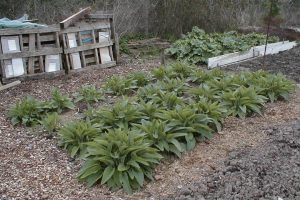Location of the Comfrey Bed
A comfrey bed is basically a permanent feature with a lifespan in excess of 20 years on your plot or in your garden so getting the site right is fairly critical. Once established, killing off comfrey is very difficult unless you resort to chemicals.

Comfrey bed located by compost heaps and the barrels for making comfrey tea saves effort in transporting the cut comfrey to where it will be used
The roots go down deeply and digging them out is hard work. Worse still, the plant will re-grow from small pieces of root left behind. Multiple applications of a systemic weedkiller like glyphosate is almost the only practical answer.
The ideal position from a growing viewpoint would be in full sun on a rich soil, well manured with a pH around 6.0 (near neutral). In other words, ideal ground for vegetable growing.
Comfrey will thrive in partial shade and doesn’t mind if the soil is fairly wet or dry. It can thrive on a poor soil if a little effort is expended in getting it established.
This means productive use can be made of part of the plot that otherwise wouldn’t see much use.
Trees and hedges nearby can be problematic. Since you’ll feed your comfrey to at least get it established, the hedge roots will naturally migrate to the area and try to steal the nutrients. A slit trench barrier may well be called for.
Usually the compost heaps will be located on unproductive ground so locating the comfrey bed by the heaps is ideal along with the barrel for making the comfrey tea.
However, if you’re growing comfrey to feed chickens or other livestock, then do consider how far from them you plant your bed. Trekking an extra distance to the livestock and back with manure every day will get annoying after a while.
Preparing The Comfrey Bed
Once established, comfrey will overshadow and overwhelm most weeds but it can be taken over by couch grass in the early years. So a thorough weeding and cleaning of the soil is the first task.
You can strip the turf from grassland and stack it to make loam or rotovate the bed a number of times over a few months to kill off most weeds and grasses.
Don’t forget to carefully dig up any perennial weeds like docks and dandelions prior to rotovating or you’ll have a mass of them growing back from bits of roots left in the soil.
The alternative is to spray off the weeds with herbicide prior to digging over or rotovating.
Deep digging and adding organic matter, especially rotted manure or compost, prior to planting will certainly get your comfrey off to a good start when planted out. It makes it easier for the roots to get down deep into the soil to get at the minerals.
In practice, especially when clearing new land, it pays to dig or rotavate as deeply as you easily can and then to at least loosen deeper soil with a fork under each planting spot.
Test the soil acidity and if needed add lime to take it up to a pH of 6.00.
If you’re short of manure or compost to add to the soil, planting a quick growing green manure such as mustard and then digging that in some 4 weeks before planting will add humus to the soil.
In the UK you can purchase both root and crown cuttings of Bocking 14 comfrey direct from the grower, Comfrey UK, growers of Comfrey Bocking 14 for over 20 years.
Further Information on Comfrey
- Growing & Using Comfrey for Gardeners
- Location & Preparing the Comfrey Bed
- How to Propagate Comfrey – Propagating Bocking 14 Comfrey
- Planting, Cultivation, Harvesting & Problems of Comfrey
- Comfrey – Medicinal Uses of Comfrey (Symphytum officinale)
- Using Comfrey: Making Comfrey Compost, Comfrey Liquid Feed or Tea
- Feeding Comfrey to Poultry and Other Livestock





